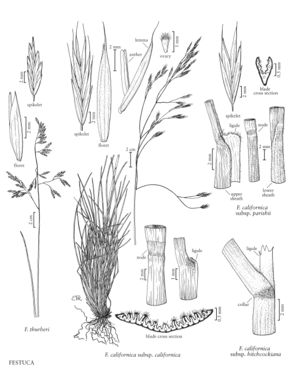Festuca thurberi
Plants densely cespitose, without rhizomes. Culms (45) 60-100 (120) cm, glabrous, smooth or scabrous below the inflorescence. Sheaths closed for less than 1/3 their length, smooth or scabrous, persistent; collars glabrous; ligules 2-5 (9) mm, entire or lacerate, not ciliate; blades 1.5-3 mm wide, 0.8-1.8 mm in diameter when conduplicate, deciduous, abaxial surfaces scabrous, adaxial surfaces scabrous or pubescent, veins 9-15, ribs 7-13; abaxial sclerenchyma a more or less continuous band; adaxial sclerenchyma present; girders usually formed at the major veins, sometimes only pillars present. Inflorescences (7) 10-15 (17) cm, open, with 1-2 (3) branches per node; branches 4.5-9 cm, lax, erect or spreading, spikelets borne towards the ends of the branches. Spikelets (8) 10-14 mm, with (3) 4-5 (6) florets. Glumes unequal to subequal, ovatelanceolate, scabrous or smooth, acute; lower glumes (2) 3.5-5.5 mm; upper glumes (2.5) 4.5-6.5 (7) mm; lemmas 6-10 mm, lanceolate to ovatelanceolate, scabrous or smooth, unawned, sometimes mucronate, mucros to 0.2 mm; paleas shorter than to as long as the lemmas, intercostal region puberulent distally; anthers 3-4.5 mm; ovary apices densely pubescent. 2n = 28, 42.
Distribution
Colo., N.Mex., Utah, S.C., Ariz., Wyo.
Discussion
Festuca thurberi is a large bunchgrass of dry, rocky slopes and hills, open forests, and meadows in montane and subalpine regions, at (1000)2000-3500 m. Its range extends from southern Wyoming south through Utah and Colorado to New Mexico.
Selected References
None.
Lower Taxa
"wider than long" is not a number."decumbent" is not a number."longest" is not a number.
